Parents’ Observation on their Child’s Behavior Diagnosed with Autism Spectrum Disorder: A Qualitative Exploration
*Azher Hameed Qamar
National University of Sciences and Technology, Islamabad, Pakistan
Hira Liaqat
University of the Punjab, Lahore, Pakistan
This article offers a qualitative analysis of the parent’s self-reported observations about their child’s behavior diagnosed with Autism Spectrum Disorder (ASD). The primary objective is to explore the parents’ observation about the behavior of the child with ASD and to gain a preliminary understanding of parental concerns that lead them to Autism Center for diagnosis. Four parents of boys were selected through purposive sampling and were interviewed. Using conventional qualitative content analysis, significant statements were extracted, and parents’ observations were sorted in different categories that were later emerged into themes. Five core categories emerged from the data; stubbornness, fixation, communication problems, poor socialization, and intellectual disability. Parental concerns included hyperactivity, repetitive behavior, communication issues, and throwing behavior. This preliminary study provides a knowledge base to improve parental counseling and widen the research horizon for further exploration. Parents’ observations reported in this study deliver an investigative platform to structure the in-depth qualitative research that will be useful to understand and contextualize the cases of ASD.
Keywords: ASD; parents’ observations, problematic behavior, intellectual disability
Autism spectrum disorders (ASD) is a multifaceted neurodevelopmental disorder that disturbs brain function and typically appears in early childhood. It is a complex developmental disorder that causes impairment in several ways and affects social interaction, communication, and behavior (Bashir & Ahmad, 2014; Shyu & Tsai, 2010). Kanner (1943) was the first psychologist who diagnosed ASD among children and found an isolated social world of the children with Autism. A description of ASD as appeared in International Classification of Diseases (WHO, 2011) says;
“Autism spectrum disorder is characterized by persistent deficits in the ability to initiate and to sustain reciprocal social interaction and social communication, and by a range of restricted, repetitive, and inflexible patterns of behavior and interests. The onset of the disorder occurs during the developmental period, typically in early childhood, but symptoms may not become fully manifested until later when social demands exceed limited capacities.”
This description further informs about the severity of deficiency caused by ASD that affects personal life, social interactions, family life, educational performance, and in several other contexts. A wide range of symptoms and the absence of clear biological indicators further add to its complexity while placing it as ‘mild’ and ‘severe’ ASD (Gupta & Singhal, 2005). Hence, the behavior is the only indicator that can help parents to show their concern about their children. However, sometimes parents as well as professionals take things for granted, hoping an improvement over time, and that causes a delay in diagnosis (Denkyirah & Agbeke, 2010). In this context, the parents who notice the behavior of their children and identify a difference in behavior can show their concerns and consult the professionals in time for proper intervention. It is also true that the majority of parents in Pakistan do not (or cannot) show this parenting behavior. There are several reasons including lack of education, lack of resources and awareness, presence of folk beliefs (such as belief in witchcraft, the evil eye), limited availability of the professionals and ASD centers, lack of infrastructure, and insufficient indigenous literature (Imran et al., 2011). Our idea to explore parents' experience of identifying their children's behavior differently than typically developing children is based on building up a base to investigate a layman's information about psychological disorder and providing a framework to expand knowledge about ASD among parents by the parents.
A Scoping Review of LiteratureThis is a short article presenting a preliminary study; hence, this scoping literature review provide an overview of the related research restricted to the symptoms of ASD as reported in different studies.
Autism Spectrum Disorder (ASD) is characterized by persistent deficits in social communication and social interaction across multiple contexts which cause clinically significant impairment in social, occupational, or other important areas of current functioning. The areas of deficits include social-emotional reciprocity, nonverbal communicative behaviors, deficits in developing, maintaining, and understanding relationships. This condition may or may not accompany intellectual or language impairment (American Psychiatric Association, 2013). The severity level is determined by the level of communication impairments, restricted, repetitive behaviors or strange patterns of behavior, stereotypic actions, unusual interests, or odd responses to the environment (Lewis & Bodfish, 1998). They have difficulties in social interactions and experience extreme isolation. They often seem to live in their world and may not pursue the company of peers or adults (Powers, 2000). They do not communicate with other people in typical ways. On average, half of the autistic children use nonverbal communication to interact or convey their message (Sturmey & Sevin, 1994). Intellectual disability, even though it is not a marker to diagnose ASD, has been observed in several children with autism (Strumey & Sevin, 1994).
By now, several studies have explored different aspects of ASD including hereditary (Geschwind, 2011), neural aspects (Oberman & Ramachandran, 2007), social support, family concerns (Bromley et al., 2004; Higgins et al., 2005), emotional impact (Posserud et al., 2010), and educational problems (Bellini et al., 2007). With varied methodologies and varied definitions, these studies cannot be compared conclusively, however, these studies reveal the multi-faceted spectrum of ASD cases. With a diverse range of difficulties, the Autistic child experiences social, emotional, and cognitive problems that complicate the conventional support and center-based intervention and do not address in-depth inter-related phenomena that lead to ASD. Hence, even if visible academic or non-academic support is there, an Autistic child may not gain the required benefits if his/her individual and social problems are not addressed simultaneously (Anderson et al., 2017).
There are a few studies that exclusively explain the experiences of parents raising autistic children (Hastings, 2003; Ilias et al., 2017; Lecavalier et al., 2006). With the increased number of ASD cases, the questions regarding the problems in the family and at the school that children experience is becoming crucial. Today ASD is not a surface level issue for the educationist and psychologists, there is a need to explore it in-depth and to contextualize it in the specific socio-cultural context. A wide variety of symptoms of Autism and its roots in early childhood makes it interesting to explore how do parents observe these children? Why do they contact the Autism Care Centers? This paper explores the answer to these questions to construct a qualitative research design for future research where parents and children may be the key participants.
Research Objectives
The article aims to understand the perspectives of the parents regarding symptoms of ASD to include their voice in the discussion on ASD. The primary objective of the study is to know the parents' observation about the behavior of the child that they found different and then contacted the professionals for intervention. This article is narrowly focused on parents' observation about behavior and does not include any professional information. This study also provides a knowledge base to improve parental counseling and widen the research horizon for further exploration.
Research Questions
The following research questions were pursued in this descriptive study.
- What are the parent's observations about the behavior of their autistic child?
- What are the conceptual categories that parents perceive as ‘disorder’?
Method
Using the unstructured interview method, qualitative research approach was used to explore parents’ observations.
Data Collection Tool
I used an unstructured interview method to collect data from the parents. An unstructured interview provided us the required flexibility to provide space to the parents to talk openly. Besides introductory questions, I asked about the medical history of the child, his/her relationship with the family, everyday social life, and the behavior that parents observed as problematic or different than other children.
Sample
Using a purposive sampling technique, six parents (for dyad interviews) were approached and four of them agreed for the interview. Parents were accessed through personal resources and to contextualize the findings, homogeneity of the sample was ensured. The sample of the study is small for two reasons. First, it is difficult to locate parents that understand the behavior problems of the child in the context of ASD and are ready to talk about it. Second, this is a preliminary study that is conducted to design a broader research project taking professionals, educationists, and parents on-board.
All the parents in this study belonged to the middle-class families and were at-least graduate. All the mothers in this study were housewives. It means that one of the parents was a fulltime primary caregiver. The families did not have any significant psychiatric history. Their children with Autism were attending the Autistic Care Centers for at-least a year and all of them reported a gradual improvement in their behavior. Some demographic information about the family is presented in the following table (table 1). ‘Dyad’ was used to represent both the parents of the child as participants.
Table 1 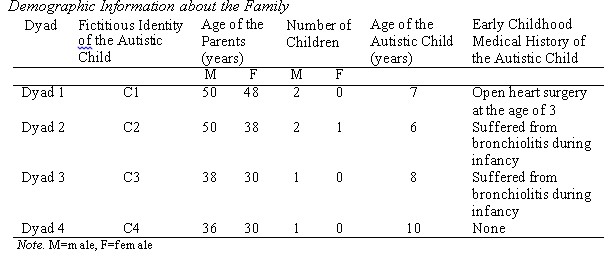
Following information about the autistic children was collected during the introductory session of the unstructured interview. The information given below provide a brief profile of the children and meet the research objective of including parents’ voices as they perceive their children’s behavior. Hence, it does not include the features of ASD diagnosed at ASD centers. To ensure confidentiality, limited information is given below using the fictitious identities of the children.
C1. C1 was born with Down's syndrome. His developmental milestones were delayed. He had learning difficulties. Moreover, he faced significant difficulties in academic activities and was not able to attend regular school. His parents sent him to a school of special education. He had a friendly relationship with his father and liked to spend time with him. His mother, who was a housewife, had a loving and caring relationship with him. C1 was the youngest child, and his elder brother was sixteen years older. C1 also had an affectionate relationship with his brother.
C2. C2 achieved his milestones at the appropriate time. During his childhood, he had high fevers most of the time. Sometimes, he had fits during high fever. He also had height phobia. His eyesight was weak, and he wore glasses. He was allergic to vegetables and spices. He was overly affectionate and sensitive. He had a friendly and expressive relationship with his parents. He did not have an expressive relationship with his siblings. However, his siblings were caring towards him.
C3. C3 suffered from Bronchiolitis when he was three months old. His developmental milestones were a little bit delayed as compared to normal children. He has a friendly relationship with his father, as compared to his relationship with his mother. His mother used to take care of all his needs and loved him very much. Both parents paid attention to him because he had limited social behavior.
C4. C4 achieved his milestones like neck holding, sitting, crawling, monosyllabic speech, and walking at an appropriate age. The child's ability to use sentences was delayed. He started sentence making at the age of 5 years. The toilet training of the client was not properly managed. He had a pleasant and friendly relationship with his parents. His mother had considerate behavior about his problems in daily life.
In all the four cases parent-child relationship was friendly and considerate. Parents showed concern for their child's mental health and that is why they were spending a lot of money. Parents did not report any marital conflict or any siblings’ inappropriate behavior to the child. Overall, the way parents reported their early concerns about their children, it was plausible that these parents were observing their children's everyday life and were conscious of their social and psychological wellbeing.
Process of AnalysisUsing conventional qualitative content analysis, significant statements were extracted from the data relevant to research questions. Each verbatim was read several times to be used as meaning unit, and statements corresponding observations on children behavior were underlined and labeled with appropriate codes. The relevant codes were clustered in conceptual categories describing problematic behavior. After categorizing the significant statements from each interview, all the categories were synthesized to precision. The precise categories were then reverse checked with all the statements to validate meanings. A descriptive analysis of the conceptual categories, followed by a short discussion, was written in connection with the significant statements.
Ethical ConsiderationsFrom all the data, only those pieces of information were shared that were not sensitive and did not compromise the confidentiality. Informed consent was taken from the parents in pre-interview meetings. It was ensured that the data will be used only for this research, that the data will only be disclosed when necessary and, and that the confidentiality will not be compromised.
Results
Results revealed that parents had a keen observation of their children behavior and noticed it consciously. Their concerns helped them to understand the psychological aspects of the problematic behavior and they contacted Autism Centers. The following tables provide the organized and sorted information along with significant statements regarding the parents’ observation about the child.
Table 2 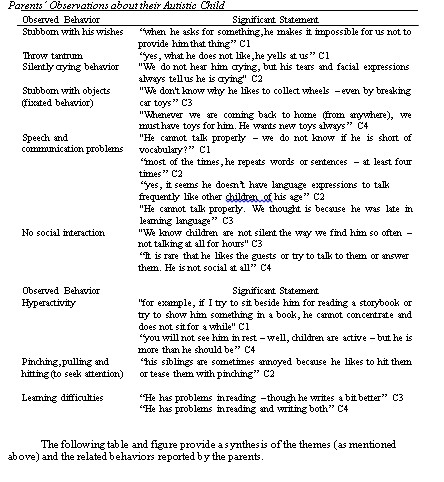
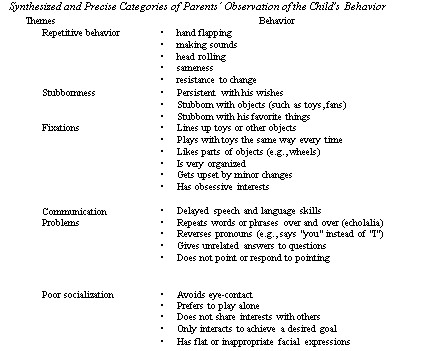
The following figure provides an illustration of parents' observations that helped them to decide to seek professional help
Figure 1 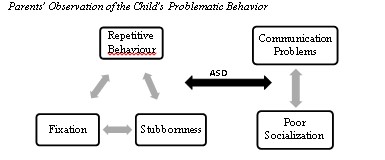
Discussion
Five core categories emerged from the data; stubbornness, fixation, repetitive behavior, communication problems, and poor socialization. Parental concerns showed hyperactivity, repetitive behavior, communication issues, and throwing behavior as major complaints. Stubbornness and repetitive behavior also indicated the fixated behavior. It seems that fixation issues are steering stubbornness and repetitive behavior, even though they are inter-related. Meanwhile, communication issues were closely connected with the socialization problems. As the socialization and communication skills are inter-related, it is evident that children are experiencing a two-way problem in interacting with other people. The developmental deficit reported by the parents is also a reason of poor socialization and communication skills. Overall, the five themes emerged from the parents’ observation, one way or other, are interconnected that parent sees as leading symptoms of a psychological disorder that was later diagnosed as ASD in autism care centers (figure 2).
Figure 2 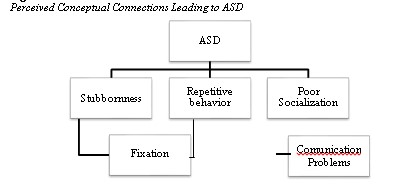
Parents' concerns, in these cases, were serious as they were educated and had a friendly relationship with the child. Hence, the behavioral problems they reported were their assumptions about the child’s psychological issues that they do not see as a normal developmental phenomenon. The study, however, is limited to the parents who are educated and can see behavioral problems in their children related to psychological issues they might have. In the Pakistani context, where parenting education is not available, parents are rarely able to perceive the psychological issues of their children (Anwar, Tahir, Nusrat, & Khan, 2018).
Conclusion
These findings raise several questions that need to be investigated in an in-depth qualitative study such as what was the early childhood experience of the child and what were the parenting and childcare practices done during early childhood? Who were the primary caretakers and how did they perform their job? When did the parents realize the problem and how was their initial response? What was the child’s kinship experience? And several other questions that can unveil the concrete and abstract world of the child during early childhood and later years. This article is useful to prepare interview guides and other research tools for further investigation. We, after exploring parents' observation reported in this article, conclude the need to design a multi-method and child-centered qualitative research to disclose the interconnected socio-psychological constructs that lead to psychological problems and are deeply rooted in childhood experiences.
Implications and Limitations of the Study
The questions regarding parents’ observation about the child’s behavior are grounded in parenting practices. It includes several other inter-connected dimensions, such as early childhood, family life, parents’ matrimonial ties, socio-economic conditions, and parent-child interactions. All of these interconnected facets can be explored in in-depth qualitative studies using multiple research methods. This research paper is significant in this regard as it provides the necessary information to design a qualitative research project including methodological strategies, interview-guides (and other research tools), and a theoretical and empirical base to probe further investigation. The study, though at a preliminary level, provides a step forward to conduct further research. Parental complaints deliver an investigative platform to structure the in-depth qualitative research that will be useful to understand and contextualize cases with ASD. As the present study has a very limited sample size (N=4), replication of the similar study with larger sample size could be beneficial as it may yield more themes.
References
American Psychiatric Association. (2013). Diagnostic and Statistical Manual of Mental Disorders, 5th Edition: DSM-5 (5th ed.). American Psychiatric Publishing.
Anderson, A. H., Stephenson, J., & Carter, M. (2017). A systematic literature review of the experiences and supports of students with autism spectrum disorder in post-secondary education. Research in Autism Spectrum Disorders, 39, 33–53. https://doi.org/10.1016/j.rasd.2017.04.002
Anwar, M. S., Tahir, M., Nusrat, K., & Khan, M. R. (2018). Knowledge, awareness, and perceptions regarding autism among parents in Karachi, Pakistan. Cureus, 10(9),3299-3311. http://doi.org/10.7759/cureus.3299
Bellini, S., Peters, J. K., Benner, L., & Hopf, A. (2007). A meta-analysis of school-based social skills interventions for children with Autism Spectrum Disorders. Remedial and Special Education, 28(3), 153–162. https://doi.org/10.1177 /07419325070280030401
Bromley, J., Hare, D. J., Davison, K., & Emerson, E. (2004). Mothers supporting children with autistic spectrum disorders. Autism, 8(4), 409–423. https://doi.org/10.1177/1362361304047224
Denkyirah, A. M., & Agbeke, W. K. (2010). Strategies for transitioning preschoolers with autism spectrum disorders to kindergarten. Early Childhood Education Journal, 38(4), 265–270. https://doi.org/10.1007/s10643-010-0407-z
Geschwind, D. H. (2011). Genetics of autism spectrum disorders. Trends in Cognitive Sciences, 15(9), 409–416. https://doi.org/10.1016/j.tics.2011.07.003
Hastings, R. P. (2003). Child behaviour problems and partner mental health as correlates of stress in mothers and fathers of children with autism. Journal of Intellectual Disability Research, 47(4–5), 231–237. https://doi.org/10.1046/j.1365-2788.2003.00485.x
Higgins, D. J., Bailey, S. R., & Pearce, J. C. (2005). Factors associated with functioning style and coping strategies of families with a child with an autism spectrum disorder. Autism, 9(2), 125–137. https://doi.org/10.1177/1362361305051403
World Health Organization. (2011). International statistical classification of diseases and related health problems (11th ed.). https://icd.who.int/
Ilias, K., Liaw, J. H. J., Cornish, K., Park, M. S.-A., & Golden, K. J. (2017). Wellbeing of mothers of children with “A-U-T-I-S-M” in Malaysia: An interpretative phenomenological analysis study. Journal of Intellectual & Developmental Disability, 42(1), 74–89. https://doi.org/10.3109/13668250.2016.1196657
Imran, N., Chaudry, M. R., Azeem, M. W., Bhatti, M. R., Choudhary, Z. I., & Cheema, M. A. (2011). A survey of Autism knowledge and attitudes among the healthcare professionals in Lahore, Pakistan. BMC Pediatrics, 11(1). http://doi.org/10.1186/1471-2431-11-107.